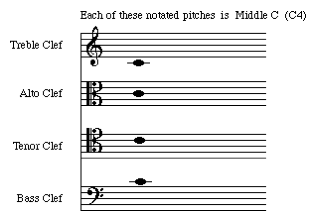| 4 |
Pitch |
| General Information |
|||||
| Pitch, in music, is the relative highness or lowness of a tone. Pitch is the musical term for the scientific concept of Frequency. Frequency is the number of beats per second something vibrates to produce a tone. The A below middle C is generally tuned to 440 beats per second. The A above middle C would then be tuned to 880 beats per second. Octaves, when in tune, function in a 1:2 or 2:1 ratio When the frequency of a tone is doubled, the pitch will be one octave higher. When the frequency of a tone is halved, the pitch will be one octave lower. Pitches are named by using the first seven letters of the alphabet: A B C D E F G Relating pitch to the piano keyboard, the pitches on the left end are the lowest and the ones on the right end are the highest. |
|||||
|
||||||
Using the pitch C as a reference point, the keyboard can be divided into octaves. An octave is the distance between a C and the next closest C. The C closest to the middle of the piano is generally referred to as "middle C." It is considered C4. Starting with the lowest C they are numbered from left to right from C1 to C8. |
|||||
|
||||||
All the pitches that lie between one C and the next are said to be in the same octave register. The register includes the lower C but the upper C begins the next register. See the diagram below. C1 D1 E1 F1 G1 A1 B1 C2 D2 E2 F2 G2 A2 B2 C3 etc. A Staff is used in music to allow us to precisely notate pitches. It consists of 5 lines and four spaces, but may be extended through the use of ledger lines. |
|||||
|
||||||
A Clef must appear at the beginning of each staff to indicate which pitches should be associated with the particular lines and spaces. |
|||||
|
||||||
A Grand Staff is a combination of two staves joined by a brace. The top clef will be the Treble Clef and the bottom will be the Bass Clef. |
|||||
|
||||||




